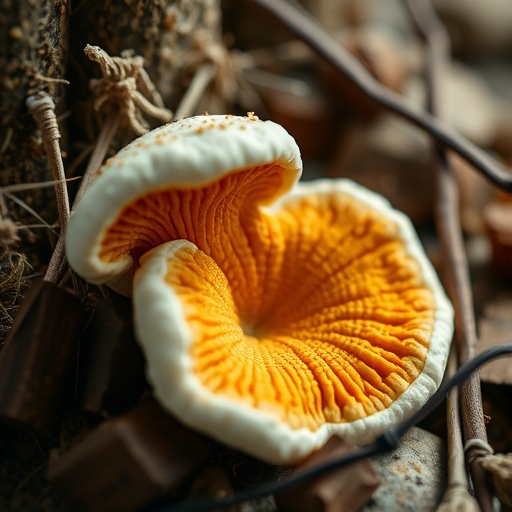Recent advancements in the field of waste conversion have drawn significant attention, particularly in the context of converting lignocellulosic biomass into valuable energy sources. One of the most promising methods under investigation is anaerobic digestion. This biological process, which takes place in the absence of oxygen, facilitates the breakdown of organic matter, converting it into biogas—a mixture of methane and carbon dioxide. As global concerns regarding energy sustainability and waste management intensify, researchers are increasingly focused on enhancing the efficiency of these processes.
A new study leads the charge in this domain, exploring the valorization of lignocellulosic biomass through anaerobic digestion. The investigation is unique in that it targets substrates derived from the cultivation of edible mushrooms, specifically the species Lentinula edodes, also known as shiitake mushrooms. The premise is simple yet profound: by optimizing the utilizations of mushroom waste, researchers aim to contribute to the circular economy and sustainable practices in agricultural and waste management sectors.
Lentinula edodes production generates substantial amounts of lignocellulosic biomass, specifically sawdust and agricultural residues, during cultivation. Traditionally, these byproducts are underutilized and often discarded, leading to a significant waste issue. However, the new study highlights how these neglected resources, when subjected to anaerobic digestion, can be transformed into renewable energy. Through their extensive experiments, the researchers demonstrate that properly managed and treated mushroom waste could yield substantial quantities of biogas.
One of the key components of this process is the pretreatment of the lignocellulosic material, a step critical for maximizing the yield of biogas. The research suggests that enzymatic pretreatment significantly enhances the digestibility of the biomass by breaking down complex carbohydrates into simpler sugars. This breakdown accelerates the subsequent anaerobic digestion phases, ensuring that microorganisms can effectively convert these sugars into energy. The findings are noteworthy as they suggest that enzymatic pretreatment enhances not only the quantity but also the quality of the biogas produced.
Moreover, the study emphasizes the importance of selecting the right enzymes for pretreatment. Different enzymes target specific bonds within the cellulose and hemicellulose structures, providing tailored solutions that optimize the breakdown process. Researchers have experimented with various commercially available enzyme preparations, observing their effects on methane production in subsequent anaerobic digestion phases. The selection process is critical, as some enzymes proved more effective than others in translating biomass into energy.
Furthermore, the researchers delve into the specifics of the digestion phase, where anaerobic microorganisms play a pivotal role. Methanogenic archaea, in particular, are crucial for the conversion of simple sugars into methane. The study compiles data on various microbial strains capable of thriving amidst the diverse byproducts resulting from mushroom cultivation. Understanding these microbial dynamics enables the recalibration of operational parameters—such as temperature, pH, and retention times—to maximize yield efficiently.
The potential societal and environmental implications of these findings are profound. By implementing the strategies uncovered in this research, communities can address several pressing issues simultaneously. Mushroom cultivation, an already popular agricultural practice, can contribute not just to food security but also to energy sustainability. Leveraging waste to produce biogas reduces reliance on fossil fuels while also mitigating the environmental impact associated with waste disposal.
Yet, the research does not shy away from acknowledging the challenges looking ahead. Scaling up laboratory findings to industrial applications remains a daunting task. Factors such as economic viability, regulatory frameworks, and regional waste management infrastructure play crucial roles in influencing the adoption of these technologies. However, the researchers remain optimistic about the future, advocating for continued investment in research and development to bridge the gap between theory and practice.
Within the wider context of global environmental goals, the findings of this study resonate strongly. Efforts to combat climate change necessitate innovative solutions to energy demands and waste management. This research provides a roadmap towards integrating waste valorization practices into everyday agricultural routines, which is essential for fostering sustainable ecosystems that benefit both society and the environment.
The economic feasibility of the processes described holds significant weight as well. Exploring potential markets, the biogas produced from mushroom waste could be a valuable asset in the energy sector, allowing for new business models that pivot around waste-to-energy paradigms. Entrepreneurs have a golden opportunity to develop frameworks around these findings, creating future jobs while fostering a greener economy.
As this research paves the way for future explorations, it begs the broader question: how can other agricultural byproducts be transformed into renewable energy? The methodologies refined through studies like this stand to benefit diverse sectors, encouraging a comprehensive view of sustainability that encompasses agriculture, waste management, and energy production.
The potential of integrating lignocellulosic biomass with emerging biotechnologies opens a multitude of avenues for innovation. As researchers continue to explore the nuances of anaerobic digestion and enzymatic processes, the possibilities for enhancing efficiency and productivity in biomass conversion will surely expand. This bidirectional relationship between academic inquiry and practical application can stimulate breakthroughs that support sustainable growth across various industries.
In conclusion, the research spearheaded by López-Balladares and his colleagues represents a significant stride towards achieving sustainability in energy production. By effectively valorizing lignocellulosic biomass from edible mushroom cultivation through anaerobic digestion and enzymatic pre-treatment, the study embodies the transformative potential of waste upcycling. As more researchers join this crusade, the hopes for a sustainable energy future become only more tangible.
Subject of Research: Valorization of lignocellulosic biomass through anaerobic digestion and enzymatic pretreatment from mushroom cultivation.
Article Title: Valorization of Lignocellulosic Biomass Through Anaerobic Digestion after the Cultivation of the Edible Mushroom Lentinula Edodes and Enzymatic Pretreatment.
Article References:
López-Balladares, O.H., De la Lama-Calvente, D., Flores-Flor, F.J. et al. Valorization of Lignocellulosic Biomass Through Anaerobic Digestion after the Cultivation of the Edible Mushroom Lentinula Edodes and Enzymatic Pretreatment.
Waste Biomass Valor (2025). https://doi.org/10.1007/s12649-025-03218-y
Image Credits: AI Generated
DOI: 10.1007/s12649-025-03218-y
Keywords: Anaerobic Digestion, Lignocellulosic Biomass, Enzymatic Pretreatment, Lentinula Edodes, Waste Valorization, Biogas Production




